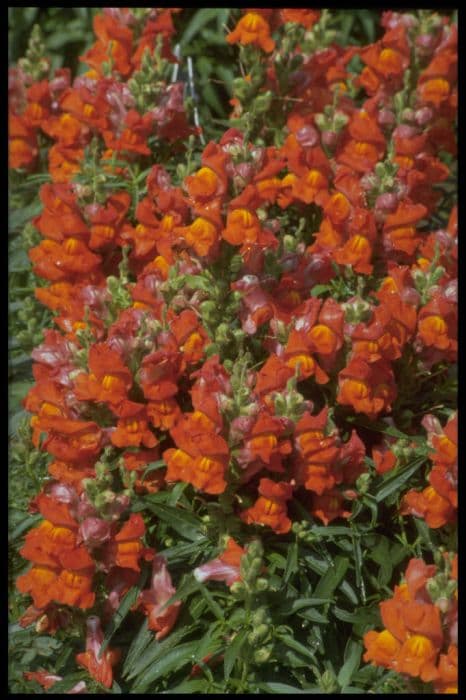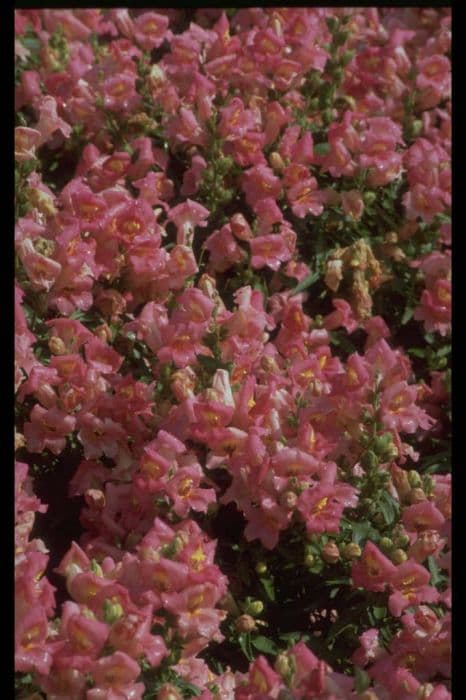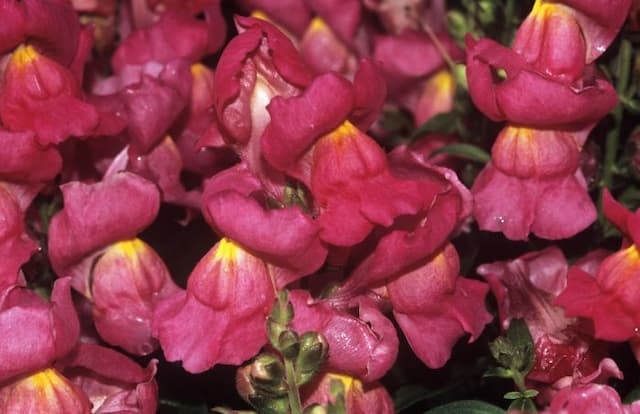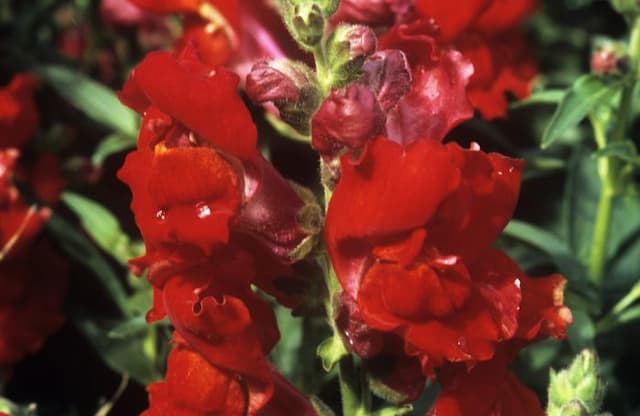Three Birds Flying Linaria triornithophora
ABOUT
Linaria triornithophora, commonly known as Three Birds Flying, is a plant that exhibits a very unique and intriguing appearance. The most striking feature of this plant is its flowers, which have an elaborate design resembling three birds in flight, hence the name. The flowers usually display a beautiful mix of colors, including shades of yellow, orange, and purple, arranged in a way that gives the impression of birds with their wings spread. The foliage of Three Birds Flying provides a contrasting backdrop to its ornate flowers. The leaves are typically narrow and elongated, with a soft green color that complements the vibrant hues of the blooms. The arrangement of the leaves is often dense, creating a lush appearance around the stems, which adds to the overall visual impact of the plant. This plant has a bushy and branched structure, and it produces a generous number of flowers, which form at the ends of the stems. The blooms are tubular and elongated, with three prominent lobes that extend outwards to form the silhouette of birds in flight. Each lobe or 'wing' can be of a different color or shade, adding to the dynamic visual effect. In terms of an overall impression, Three Birds Flying exudes an air of whimsy and charm. Its unique flowers are a focal point and often become a topic of conversation for their unusual shape and vibrant colors. The overall appearance is one of liveliness and a sense of motion, making this plant a captivating addition to any garden or floral display where the size of plants is not a primary concern.
About this plant
 Names
NamesFamily
Plantaginaceae
Synonyms
Three Birds Flying Linaria
Common names
Linaria triornithophora.
 Toxicity
ToxicityTo humans
The plant Linaria triornithophora, commonly known as Three Birds Flying, is not well-documented for its toxicity to humans in the available literature up to early 2023. Due to the lack of specific information on its toxicity, it should be considered potentially harmful, especially if any part of the plant is ingested. In the absence of concrete data, treating this plant with caution is advisable, and if ingestion occurs, medical attention should be sought. Knowledge about this plant may evolve, so always refer to the most recent sources for updated information on its toxicity.
To pets
The Linaria triornithophora, also known as Three Birds Flying, is not specifically reported for its toxicity to pets in the widely accessible references up to early 2023. Without concrete information on its toxicity to animals, it should be presumed potentially hazardous, akin to many plants that have not been thoroughly studied. If pets ingest any part of this plant, they should be monitored for any signs of distress, and a veterinarian should be consulted immediately. Keep in mind that individual pets might react differently to plants, and toxicity can vary widely among different species.
 Characteristics
CharacteristicsLife cycle
Annuals
Foliage type
Deciduous
Color of leaves
Green
Flower color
Purple
Height
2 feet (60 cm)
Spread
1 foot (30 cm)
Plant type
Herb
Hardiness zones
8
Native area
Europe
Benefits
 General Benefits
General Benefits- Ornamental Value: Adds aesthetic appeal to gardens with its unique three-spurred flowers and vibrant colors.
- Biodiversity Support: Acts as a food source for pollinators such as bees and butterflies, supporting local ecosystems.
- Low Maintenance: Requires minimal care once established, making it suitable for gardeners of all skill levels.
- Drought Tolerance: Adapted to survive with less water, making it suitable for xeriscaping and reducing the need for irrigation.
- Fast Growing: Quick to germinate and reach maturity, allowing for rapid establishment in the garden.
- Edging and Border Planting: Its compact growth habit makes it an excellent choice for creating defined edges and borders in landscaping designs.
- Soil Erosion Control: Helps in stabilizing soil and preventing erosion in garden areas prone to this problem.
 Medical Properties
Medical PropertiesThis plant is not used for medical purposes.
 Air-purifying Qualities
Air-purifying QualitiesThis plant is not specifically known for air purifying qualities.
 Other Uses
Other Uses- Three Birds Flying Linaria can be used as a colorful addition to themed gardens, especially those designed to mimic the appearance of a natural meadow or prairie.
- This plant's unique appearance, with flowers resembling little birds, makes it suitable as an educational tool in garden programs aimed at teaching children about plant pollination and morphology.
- The fresh or dried flowers of Three Birds Flying Linaria can be used in floral arrangements to provide an unusual and whimsical touch.
- Due to its shape, it can also be incorporated into garden art installations to provide a living component that adds texture and interest.
- Gardeners may use Three Birds Flying Linaria as a border plant in landscaping to take advantage of its height and distinctive flowering spires.
- The vibrant colors of the blooms are useful for artists and naturalists to study and replicate in various forms of botanical art and illustration.
- This plant could serve as a motif or inspiration for designers in creating patterns or prints for textiles and wallpaper given its unique floral structure.
- Three Birds Flying Linaria seeds can be used as part of a seed mix for creating a wildflower garden, benefiting pollinators like bees and butterflies.
- It can act as a companion plant in the vegetable garden to attract pollinators and potentially improve fruit set on crops that require insect pollination.
- Three Birds Flying Linaria might be used in photography as a striking subject for macro photography, showcasing the intricate details of the flowers.
Interesting Facts
 Feng Shui
Feng ShuiThe plant Three Birds Flying is not used in Feng Shui practice.
 Zodiac Sign Compitability
Zodiac Sign CompitabilityThe plant Three Birds Flying is not used in astrology practice.
 Plant Symbolism
Plant Symbolism- Flight and Freedom – The bird-like appearance of the Linaria triornithophora flowers, often referred to as the "Bird's-foot violet," suggests themes of freedom and the ability to rise above life's challenges.
- Unique Beauty – With its distinctive shape and the unusual number of spurs resembling bird's feet, this plant symbolizes the unique and unconventional beauty found in diversity.
- Adaptability – Linaria triornithophora grows in various habitats, representing the ability to adapt and thrive in different environments and circumstances.
 Water
WaterThe Three Birds Flying Snapdragon, commonly known as Linaria triornithophora, should be watered regularly, ensuring the soil remains moist but not waterlogged. Aim to water the plant once every week, but adjust frequency according to temperature and seasonal changes. When watering, provide enough water so that it runs out the bottom of the pot, approximately 16-24 ounces. During the active growing season in spring and summer, they may require more frequent watering. Always check the top inch of the soil for dryness before watering again.
 Light
LightFor the Three Birds Flying Snapdragon, it is best to provide full sun to partial shade. Locate the plant in a spot where it can receive at least six hours of direct sunlight daily, while also having some relief during the hottest part of the day. Bright, indirect light can suffice if direct sunlight is too intense, particularly in the peak of summer.
 Temperature
TemperatureThe ideal temperature range for the Three Birds Flying Snapdragon is between 50°F and 70°F. It is crucial to avoid frost, as the plant cannot withstand temperatures below 40°F. It can tolerate up to about 80°F but might require additional care like shading or increased watering if temperatures rise consistently above this.
 Pruning
PruningTo promote bushier growth and more blooms, the Three Birds Flying Snapdragon should be pruned by pinching the tips during the spring. Snip off spent flowers to encourage continuous blooming. Pruning is generally required every few weeks during the growing season or when the plant appears leggy.
 Cleaning
CleaningAs needed
 Soil
SoilThree Birds Flying prefers well-draining soil with a mix of sand, peat, and loam with a 6.0 to 7.5 pH level.
 Repotting
RepottingThree Birds Flying should be repotted every 1-2 years or when it outgrows its current container.
 Humidity & Misting
Humidity & MistingThree Birds Flying thrives in moderate to high humidity conditions, ideally around 50% or higher.
 Suitable locations
Suitable locationsIndoor
Place Three Birds Flying in bright, indirect light indoors.
Outdoor
Ensure full sun to partial shade and shelter from strong winds for Three Birds Flying.
Hardiness zone
4-9 USDA.
 Life cycle
Life cycleLinaria triornithophora, commonly known as the Three Birds Flying Plant, begins its life cycle from a seed, which upon germinating, develops into a small seedling. The seedling then grows into a vegetative plant, establishing roots and shoots that will form the plant’s structure. As it matures, the plant produces leaves and stems, preparing for the flowering stage. During the flowering stage, the plant showcases its unique flowers, which resemble three birds in flight, a feature that is vital for pollination. Following pollination, the plant sets seeds, completing its reproductive cycle. The seeds are then dispersed to give rise to new plants, and the parent plant may die afterwards if it is an annual, or continue this cycle if it is a perennial.
 Propogation
PropogationPropogation time
Spring to Summer
Propogation: Linaria triornithophora, commonly known as Three Birds Flying, is typically propagated by seed. The optimal time to sow seeds is in spring, after the danger of frost has passed, or indoors several weeks before the last expected frost. To propagate, scatter the tiny seeds atop moist, well-drained seed starting mix, lightly pressing them into the surface without covering them, as they need light to germinate. Maintain the moisture and keep the seed trays in a warm, bright location. Germination usually occurs within two to three weeks. Once seedlings have developed true leaves and are large enough to handle, they can be transplanted into individual pots and eventually moved to their final location in the garden when they are robust enough and temperatures are consistently warm.









